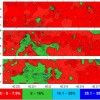Abstract
Managing soil moisture properly through irrigation is key to increasing crop yield and conserving water. By understanding soil moisture variability, growers can better manage their irrigation systems to apply the right amount of water at the right time. This 4-page fact sheet proposes guidelines for soil moisture sampling that account for spatial variability, which helps to determine the minimum number of soil moisture sensors required to survey and monitor a specific area for irrigation. Written by Lincoln Zotarelli, Michael D. Dukes, and Marcelo Paranhos, and published by the UF Department of Horticultural Sciences, July 2013.
References
Goovaerts, P. 1997. Geostatistics for Natural Resources Evaluation. Oxford, England: Oxford University Press.
Mann, K. K., A. W. Schumann, T. A. Obreza, W. G. Harris, and J. B. Sartain. 2012. How to Characterize Soil Variability in Florida Citrus Groves as It Relates to Tree Growth and Yield. SL556. Gainesville: University of Florida Institute of Food and Agricultural Sciences. http://edis.ifas.ufl.edu/ss557.
Unless otherwise specified, articles published in the EDIS journal after January 1, 2024 are licensed under a Creative Commons Attribution-NonCommercial-NoDerivs 4.0 International (CC BY-NC-ND 4.0) license.

